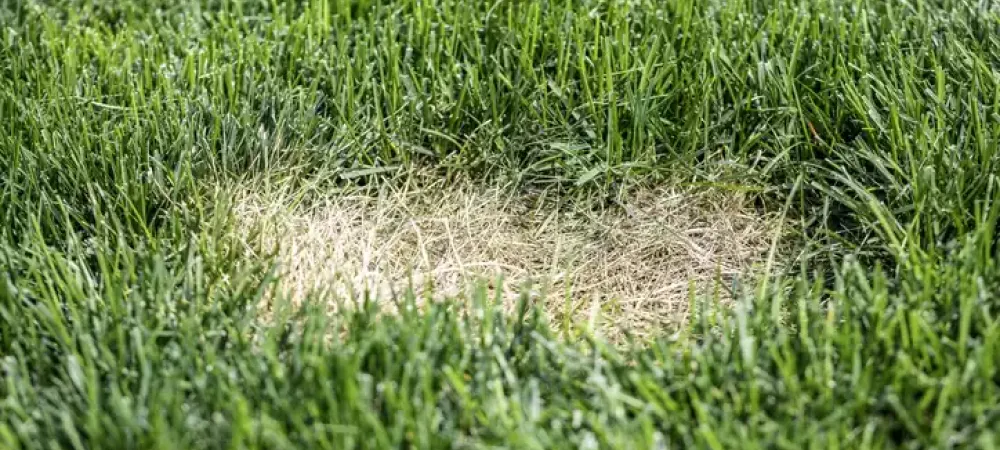Lawn Disease Prevention in Humid Climates: Aeration + Proper Watering Schedule

Humidity is a lawn’s worst enemy. In regions like Georgia, where muggy summer mornings and dew-soaked nights are the norm, fungal lawn diseases can thrive if not managed proactively. Understanding how to prevent lawn disease starts with two core strategies: routine aeration and a proper watering schedule. Learn from experts how to diagnose, treat, and prevent your lawn from damaging diseases.
Common Lawn Diseases in Humid Climates
Fungal diseases tend to take hold when grass remains wet for extended periods, especially during stretches of high humidity. Here are four of the most common culprits in the Southeast:
- Brown Patch: Causes circular patches of brown or tan grass, often with a darker border. Thrives in wet, warm conditions—typically at night when humidity remains high.
- Dollar Spot: Presents as small silver-dollar-sized spots that grow together into larger tan patches. It favors low nitrogen and excess moisture.
- Pythium Blight: Also known as "greasy spot," this disease spreads rapidly during hot, humid nights and leaves a slimy residue.
- Fairy Ring: Recognized by rings of dark green grass or mushrooms. It alters soil biology and reduces nutrient absorption.
These diseases not only damage turf appearance—they weaken the lawn's overall health and make it more susceptible to drought, pests, and further fungal outbreaks.
How Aeration Strengthens Disease Resistance
Core aeration helps fight disease from the ground up. By pulling plugs of soil from the turf, it relieves compaction and allows air, water, and nutrients to reach the root zone. This promotes stronger root systems and healthier grass that’s more resistant to fungal invasion.
Benefits of lawn aeration include:
- Improved oxygen flow to the roots.
- Better water absorption, reducing pooling and wet leaf conditions.
- Enhanced microbial activity that helps suppress disease.
- Thicker turf, which prevents pathogens from taking hold.
In humid climates, aeration is especially important because saturated soils stay wetter longer, creating ideal conditions for fungal spores to spread.
How to Water Lawn to Prevent Disease
Watering isn’t just about keeping your lawn green—it’s about doing it correctly. Overwatering or watering at the wrong time of day can invite fungal growth.
Here’s what to keep in mind:
- Water deeply but infrequently: Aim for 1 inch of water per week, including rainfall. Shallow, daily watering increases surface moisture and disease risk.
- Water early in the morning (before 9 AM): This gives the grass time to dry out during the day.
- Avoid watering in the late afternoon or evening, when moisture will linger on leaves overnight—prime conditions for fungal development.
- Monitor soil moisture regularly. If the top 4–6 inches are dry, it’s time to water.
Integrated Lawn Disease Management
Preventing lawn disease isn’t about one tactic—it’s a combination of smart practices that work together:
- Aerate in early spring or fall when the lawn is actively growing.
- Apply fungicide preventively or at the first sign of disease, especially during periods of high humidity.
- Mow at the correct height for your grass type to avoid stressing the turf (typically 2.5–3.5 inches for most warm-season grasses).
- Sharpen mower blades to prevent tearing grass, which can leave entry points for disease.
Signs of Lawn Disease to Watch For
Catching lawn disease early gives you the best shot at managing it quickly. Be on the lookout for:
- Circular patches or rings in the lawn.
- Grass that appears greasy, slimy, or spotted.
- Thinning or discolored areas that don’t respond to watering.
- Mushrooms or sudden color changes.
If you notice any of these symptoms, act immediately to prevent further issues.
Protect Your Lawn with an Expert Prevention Plan
WinLAWN offers comprehensive lawn disease control tailored for your specific needs. At WinLAWN, our technicians are trained to recognize the signs of common Georgia lawn diseases and apply targeted treatments as needed. We'll inspect your lawn, identifying issues like brown patches, thinning grass, or unusual wilting, we start by identifying whether fungus is the underlying cause.
We then use a combination of fungicides depending on the disease, timing, and severity. These work best when paired with good lawn care practices like aeration and proper mowing. Together, these steps help improve airflow, reduce compaction, and create an environment where healthy turf can outcompete disease.
Humidity doesn’t have to win. Start protecting your lawn today with the right combination of science, service, and seasonal timing.